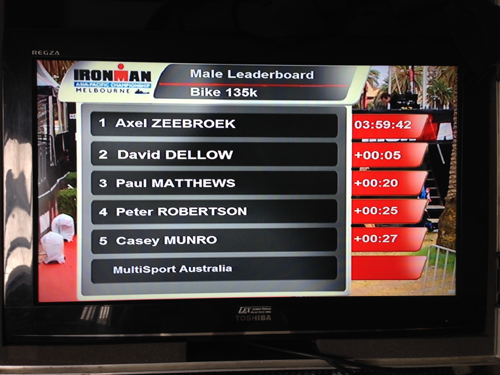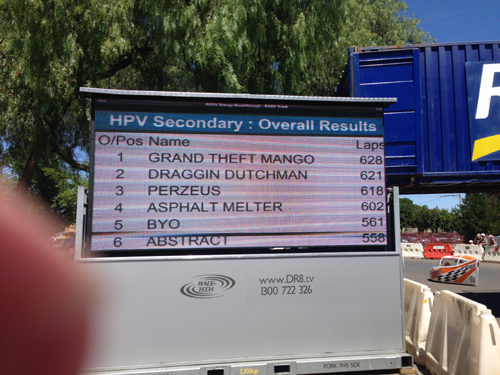Kevin Farmer, owner of
Results Base in the United Kingdom is my second-longest standing RaceTec user (he came on board in around 2004 if I remember correctly), so when he asked if I could come over to assist at the Brownlee Triathlon on 26 September, I didn't hesitate.
He had been asked to ensure that the large outdoor display screen, showing leaderboard information, looked as professional as possible. I have long been thinking of developing a system to handle these types of displays, and this was the perfect opportunity to test it out.
The brief was to provide a display that alternated between:
1. The last few finishers and their times, and
2. The top 5 men and women in each distance.
To give you an idea of what I'm talking about, here is a photograph showing the top 5 men:
The 'wavy' effect is due to the refresh rate of the display screen interfering with the camera, to the naked eye the display was perfectly clear.
What you see in the picture is actually some text overlayed on a background image. The background has the top logo, the top colours, and the 5 blue bars.
The RaceTec display screen module places the text where required.
Below the screen, in the van, is a control system used to manage the display. I placed a laptop in there, and the display operator hooked it into his controller using an HDMI cable. This is essentially how TV broadcast graphics are done, except my system uses a basic laptop, whereas professional broadcasters use specialised electronic equipment and software to achieve the same thing.
The display screen module allows you to customise the text by changing the font size and colour, the location of each data field, spacing in between the lines, location of the headers, etc. This positioning of the text can only be done on-site where it is possible to preview the result. Generally these screens are very low resolution compared to a computer screen, so fonts need to be as big and as clear as possible. So you need to weigh up clarity against amount of data shown. The above display would not have been able to display the top 10 men, because then the font would have had to be much smaller, and it would not be readable.
These settings can all be adjusted in "real time", in other words as you change them, the display adjusts live and you can see immediate results.
Anyway, the system was a great success which I was very pleased about. The display screen module can be set up to automatically swop between the different display types (leaderboard, results, current finishers, etc), so you don't have to have an operator sitting there managing it. In a TV broadcast, for example, there will be at least one 'graphics operator' who sits in one place for the entire broadcast, selecting which graphics to display depending on what the producer wants. As a race timer you probably can't afford a staff member just doing that all day, so automation is essential.
The second display (not shown above) worked a bit like a commentator display, showing names and times as competitors crossed the finish line. Spectators loved this and the area in front of the display was always full of supporters taking photos of their loved one's name on the big screen. These large displays definitely add a new dimension to a race atmosphere, if managed properly.
Here are another two examples of the display screen module in action. The first picture was a live broadcast of an Ironman event (I took a picture of a TV screen in the timing office). And the second is a multi-lap race (please excuse the finger!).


As with all RaceTec modules, if you have a full licence then the display screen module is included, there is no additional cost.